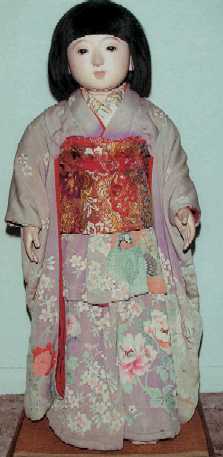|
|
Mrs. Frances D. Whittemore, director of the Mulvane art museum, has recently received a letter from the Committee on World Friendship Among Children in New York, saying that the committee has decided to assign one of the dolls to the Mulvane art museum. The dolls are being distributed, one to each state, for permanent residence in museums, where they will be a continual reminder to the people, and especially to the children, of the good will gesture of the children of Japan. Value is $200. Beautiful Miss Miyagi, the doll-ambassador assigned to Topeka, arrived this week. She is about 32 inches tall and stands on a platform, supported by a metal rod at the back, which grips her obi, or sash. She is accompanied by quite an outfit of accessories consisting of gold and silver inlaid lacquer articles. The doll with her accessories costs about $200. Made in Tokyo, by veritable artists in doll-making, they are carved entirely of wood. Their bodies are jointed, so that they can sit, or kneel, as Japanese ladies must when they prepare the ceremonial tea. Their delicately beautiful faces express the gentle reserve of the Orient. Each doll is dressed in three exquisite silken kimonos, worn one above the other. The outer kimono is hand-painted with a lovely design embodying the prefecture which she represents. Miss Miyagi wears a violet kimono with embroidered chrysanthemums, peach blossoms and the pink blossoms of the tree-peony.
In each prefecture one of the leading noble families granted permission to the friendship dolls to wear the family coat-of-arms, and these tiny insignia are embroidered in five places on the kimono. It is evident that very much thought, art, and love went into the preparation of this gift from the children of Japan to the children of America. After the money had been collected, half-cent by half-cent, and the dolls made and provided with dresses and doll furniture--for each doll has a complete outfit--they were distributed to each prefecture, and the school children gathered and bade a ceremonial farewell to their doll-messenger. When the dolls set forth for America, the American ambassador, members of the cabinet, and a royal princess attended their farewell party. The doll-makers and artist craftsmen were also on the pier, and thousands of Japanese school children watched the steamer out of sight, waving their hands, as tho they were living children. Each one had her steamship ticket made out in due form, showing her entitled to a half-fare passage furnished free by the steamship company. Each one had her passport with her photograph affixed, a regulation personal description, by which she might be identified. Are Given Receptions. The passports are addressed, "To all young friends in the United States," and read: "You are kindly requested to accept the pretty bearer of this passport of good will as a messenger sent by your young friends in Japan to convey to you their sentiment of warm regard and friendship. Please be good to her, and she will stay with you all her life, always a pleasant companion and a true friend." Signed. "All the People of the Land of Cherry Blossoms. October 30, 1927." The dolls came to this country under the care of Director Sekiya of the bureau of education in Japan, who styles himself their "uncle." In his official capacity he received the American dolls which were sent to Japan last year. From San Francisco the dolls were taken aboard ferries and enthusiastically received by the cities across the bay. Then they were taken aboard train and started across the continent to New York. They arrived in the United States in time for Christmas, as their Japanese donors intended; but since it was manifestly impossible for all American children to see them at Christmas time, they have been making visits ever since the holidays in various cities and towns thru which their journey has taken them. There have been elaborate ceremonies of reception in several different cities. Carries Vanity Case. Miss Miyagi has just been attending the teachers' convention of the National Education association in Minneapolis, and came to Topeka directly from there. Like her American sisters she carries a vanity case containing a mirror and a jeweled hairpin. This she wears tucked in the folds of her wide girdle, the obi, that is held up with a narrower belt called obisimi. The flowing sleeves of her kimono fall almost to the floor. Her straight, inky-black hair is worn in a long bob that reaches her shoulders. Her delicate cheeks and lips blush with a taint pink. She is indeed a fitting representative of the Blossom Land from which she comes--a gift from the friendly children of one great country to their brothers and sisters of another. The doll will not be on exhibit until the opening of the art museum in the autumn. Several events are being planned for her reception and introduction to the public at that time. |
Photo used with permission of Margaret Corbet
 Wears Coats-of-Arms.
Wears Coats-of-Arms.